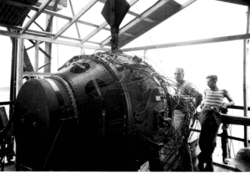Fat Man
|
|
Fat_man.jpg
"Fat-Man" was the codename of the nuclear weapon which was detonated over Nagasaki, Japan by the United States, on August 9, 1945. It was the second and, so far, the last known nuclear weapon to be used in assault. The name also refers more generically to the early designs of U.S. weapons based on the "Fat Man" type.
The 7-foot 8-inch (3.25 metres) long, five-foot (1.52 metres) diameter, 10200-pound (4545 kg) weapon detonated at an altitude of about 1,800 feet (550 m) over the city. It was dropped from the B-29 bomber Bockscar, piloted by Major Charles Sweeney. The bomb had a yield of about 25 kilotons, or 8.4×1013 joule = 84 TJ (terajoule), slightly more than the bomb known as "Little Boy" dropped on Hiroshima three days earlier. Due to Nagasaki's hilly terrain, the damage was somewhat less extensive than that in relatively flat Hiroshima. An estimated 40,000 people were killed outright by the bombing at Nagasaki, and about 25,000 were injured.[1] (http://www.yale.edu/lawweb/avalon/abomb/mp10.htm) Many more thousands would die later from related injuries, poisoning and nuclear fallout/radiation.
"Fat Man" was an implosion type weapon using plutonium. A subcritical sphere of plutonium was placed in the center of a hollow sphere of high explosive. Numerous detonators located on the surface of the high explosive were fired simultaneously to produce a powerful inward pressure on the core, squeezing it and increasing its density, resulting in a supercritical condition and a nuclear explosion.
Implosion_Nuclear_weapon.png
Illustration of the implosion concept.
At first it was thought that two pieces of sub-critical plutonium (Pu-239) could simply be shot into one another to create a nuclear explosion, and a plutonium gun-type design of this sort (known as the "Thin Man" bomb) was worked on for some time during the Manhattan Project. However it was discovered that plutonium created for the bomb in the nuclear reactors at Hanford, Washington, was not as pure as the initial samples of plutonium developed at the cyclotrons at UC Berkeley. Because of the presence of the isotope Pu-240, reactor-bred plutonium had a much higher rate of spontaneous neutron emission than was previously thought, and if a gun-type device was used it would most likely pre-detonate and result in a messy and costly "fizzle". After this problem was realized in 1943, work began in earnest on the implosion bomb, the "Fat Man". It is theoretically possible to build a plutonium gun-type device, but it would need to be 19 feet long in order to allow the sub-critical masses to be fused into a critical mass before a fizzle occurs. The mass of a plutonium gun-type device would have been beyond the payload of the B-29.
The gun-type method could still be used for highly-enriched uranium, though, and was employed in the "Little Boy" weapon which was used against Hiroshima, Japan. For a variety of reasons, the implosion method is both more efficient than the gun-type method, and also far safer, as a perfect synchronization of the explosion lenses is required for the core to properly detonate, reducing the chances greatly of an accidental nuclear detonation.

Because of its complicated firing mechanism, and the need for previously untested synchronization of explosives and precision design, it was felt that a full test of the concept was needed before the scientists and military representatives could be confident it would perform correctly under combat conditions. On July 16, 1945, a device utilizing a similar mechanism (called the "gadget" for security reasons) detonated in a test explosion at a remote site in New Mexico, known as the "Trinity" test. In the end, it gave somewhere around 20 kt, 2 to 4 times the expected yield.
The Soviet Union's first nuclear weapon detonated at Operation First Lightning (known as "Joe-1" in the West) was more or less a purposeful copy of the "Fat Man" device, on which they had obtained detailed information from the spy Klaus Fuchs.
Immediately after the bombings of Japan, the United States produced a technical history of the Manhattan Project known as the Smyth Report, which did not mention the "Fat Man" device as being different from the "Little Boy" device, or imply at all that a different method was required for plutonium weapons. The "implosion" design was considered top-secret in the United States until it was declassified and released during the testimony of David Greenglass again Julius and Ethel Rosenberg in 1951. Photographs of the casings of "Little Boy" and "Fat Man" were not released publicly until the 1960s.
The United States produced a small stockpile of "Fat Man" bombs after the war, but they were highly idiosyncratic and extremely delicate. It was eventually re-worked in the MK 4 Fat Man bomb, which was similar in principle but was appropriate for long-term stockpiling, use by non-experts, and used a more efficient implosion system (with a 60 point implosion system, compared to the 32 point weapon used in the war).
Schematic cross-section of the "gadget"; some boundaries are approximate. From left to right (outside inward):
- dural casing, ~140 cm inner diameter
- exploding-bridgewire detonator (allows for instantaneous detonation of explosives)
- faster explosive, Composition-B; 60% RDX, 39% TNT, 1% wax
- slower explosive (Baratol)
- faster explosive, "amplifier"
- aluminum–boron "pusher" (absorbs stray neutrons and widens/smooths implosion pulse)
- natural-uranium "tamper" (neutron reflector, inertial containment, improves efficiency, reduces the amount of fission material needed)
- the "pit"; plutonium-239–plutonium-240–gallium delta-phase alloy (96%–1%–3% by molality) (fissionable material)
- air gap
- beryllium–polonium-210 "initiator" (the "urchin"), neutron source
See also
External links
- thorough descriptions of Gadget (http://gawain.membrane.com/hew/Nwfaq/Nfaq8.html#nfaq8.1.2) ("a great deal of tissue paper and scotch tape were used to make everything fit snugly") and Fat Man (http://gawain.membrane.com/hew/Nwfaq/Nfaq8.html#nfaq8.1.4) at Nuclear Weapons Archive
af:Fat Man de:Fat Man fr:Fat Man ja:ファットマン pl:Fat Man zh:胖子原子彈

